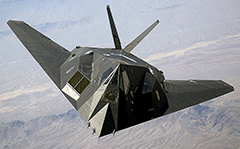Lockheed F-117 Nighthawk
The Lockheed F-117 Nighthawk is a single-seat, twin-engine stealth attack aircraft that was developed by Lockheed's secretive Skunk Works division and operated by the United States Air Force (USAF). The F-117 was based on the Have Blue technology demonstrator, and was the first operational aircraft to be designed around stealth technology. The maiden flight of the Nighthawk took place in 1981, and the aircraft achieved initial operating capability status in 1983. The Nighthawk was shrouded in secrecy until it was revealed to the public in 1988.
 Lockheed F-117 Nighthawk was widely publicized for its role in the Persian Gulf War of 1991. Although it was commonly referred to as the "Stealth Fighter", it was strictly an attack aircraft. F-117s took part in the conflict in Yugoslavia, where one was shot down by a surface-to-air missile (SAM) on 27 March 1999; it was the only Nighthawk to be lost in combat. The U.S. Air Force retired the F-117 on 22 April 2008, primarily due to the fielding of the F-22 Raptor. Sixty-four F-117s were built, 59 of which were production versions, with the other five being demonstrators/prototypes.
Lockheed F-117 Nighthawk was widely publicized for its role in the Persian Gulf War of 1991. Although it was commonly referred to as the "Stealth Fighter", it was strictly an attack aircraft. F-117s took part in the conflict in Yugoslavia, where one was shot down by a surface-to-air missile (SAM) on 27 March 1999; it was the only Nighthawk to be lost in combat. The U.S. Air Force retired the F-117 on 22 April 2008, primarily due to the fielding of the F-22 Raptor. Sixty-four F-117s were built, 59 of which were production versions, with the other five being demonstrators/prototypes.
The F-117's unusual design surprised and puzzled experienced pilots; a Royal Air Force pilot who flew it as an exchange officer while still secret stated that when he first saw a photograph of the F-117, he "promptly giggled and thought to himself 'this clearly can't fly'". Early stealth aircraft were designed with a focus on minimal radar cross-section (RCS) rather than aerodynamic performance. Highly-stealth aircraft like the F-117 Nighthawk are aerodynamically unstable in all three aircraft principal axes and require constant flight corrections from a fly-by-wire (FBW) flight system to maintain controlled flight. It is shaped to deflect radar signals and is about the size of an F-15 Eagle.
The single-seat Nighthawk is powered by two non-afterburning General Electric F404 turbofan engines. It is air refuelable and features a V-tail. The maximum speed is 623 miles per hour (1,003 km/h) at high altitude, the max rate of climb is 2,820 feet (860 m) per minute, and service ceiling is 43,000 to 45,000 feet (13,000 to 14,000 m). The cockpit was quite spacious, with ergonomic displays and controls, but the field of view was somewhat obstructed, with a large blind spot to the rear. More details
 Lockheed F-117 Nighthawk was widely publicized for its role in the Persian Gulf War of 1991. Although it was commonly referred to as the "Stealth Fighter", it was strictly an attack aircraft. F-117s took part in the conflict in Yugoslavia, where one was shot down by a surface-to-air missile (SAM) on 27 March 1999; it was the only Nighthawk to be lost in combat. The U.S. Air Force retired the F-117 on 22 April 2008, primarily due to the fielding of the F-22 Raptor. Sixty-four F-117s were built, 59 of which were production versions, with the other five being demonstrators/prototypes.
Lockheed F-117 Nighthawk was widely publicized for its role in the Persian Gulf War of 1991. Although it was commonly referred to as the "Stealth Fighter", it was strictly an attack aircraft. F-117s took part in the conflict in Yugoslavia, where one was shot down by a surface-to-air missile (SAM) on 27 March 1999; it was the only Nighthawk to be lost in combat. The U.S. Air Force retired the F-117 on 22 April 2008, primarily due to the fielding of the F-22 Raptor. Sixty-four F-117s were built, 59 of which were production versions, with the other five being demonstrators/prototypes.The F-117's unusual design surprised and puzzled experienced pilots; a Royal Air Force pilot who flew it as an exchange officer while still secret stated that when he first saw a photograph of the F-117, he "promptly giggled and thought to himself 'this clearly can't fly'". Early stealth aircraft were designed with a focus on minimal radar cross-section (RCS) rather than aerodynamic performance. Highly-stealth aircraft like the F-117 Nighthawk are aerodynamically unstable in all three aircraft principal axes and require constant flight corrections from a fly-by-wire (FBW) flight system to maintain controlled flight. It is shaped to deflect radar signals and is about the size of an F-15 Eagle.
The single-seat Nighthawk is powered by two non-afterburning General Electric F404 turbofan engines. It is air refuelable and features a V-tail. The maximum speed is 623 miles per hour (1,003 km/h) at high altitude, the max rate of climb is 2,820 feet (860 m) per minute, and service ceiling is 43,000 to 45,000 feet (13,000 to 14,000 m). The cockpit was quite spacious, with ergonomic displays and controls, but the field of view was somewhat obstructed, with a large blind spot to the rear. More details
